10 Things We Learned From WWE Survivor Series 2001
The one with Team WWF vs. The Alliance...
It was incomprehensible that WWE could take a sure-fire, undoubted winner of a storyline like a WCW invasion and render it so sterile and lifeless. The idea that the most sought-after pro-graps holy war was about to theoretically play out in scripted form on our TV sets was delectable and exciting, and that WWE bungled it with Clouseau-like deftness is still a sore point for many today. Calling the Invasion a dud is a disservice to other duds that at least provided ironic amusement.
Survivor Series 2001 would be the battleground in which the "moment of truth" took place, not that it was the culmination of an epic story. Instead, the event felt more like the jettisoning of a burden, a way to write off the entire sorry mess in one night, before moving on to matters that a victorious Vince McMahon would rather sink his creative teeth into.
It must be said that for the most part, the 2001 Survivor Series was a pretty enjoyable show, with an exciting five-on-five main event, and two unification matches were up to snuff. It was, however, hard to override the disappointing taste of the squandered storyline, that although WWE made somewhat good on the high stakes on the angle's last day, it doesn't undo all the prior damage.
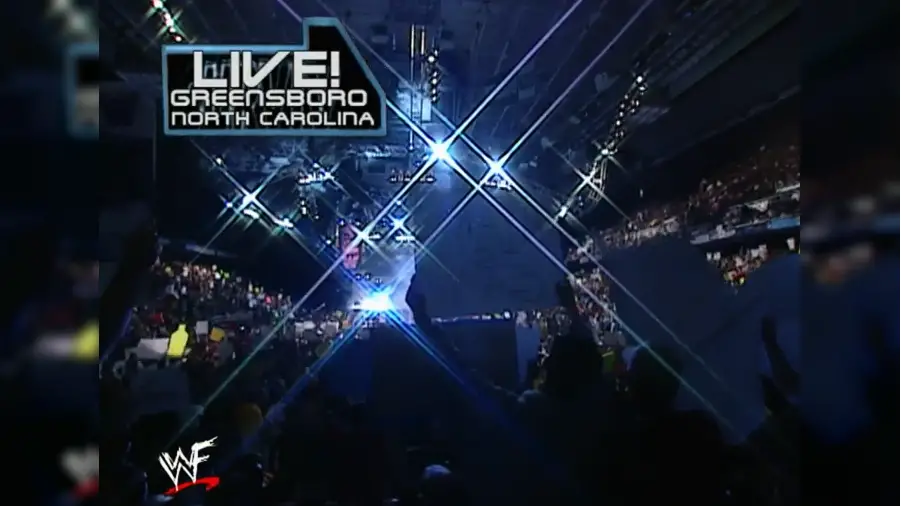 WWE
WWE
After the dust settled at WrestleMania X-Seven, interest in the WWE product began to slowly wane. Trendies had flocked elsewhere, the wrestling boom was dying, and Stone Cold Steve Austin was no longer the cool anti-hero that had starred in WWE's resurgence. Perhaps a hearty Invasion angle could have bolstered the fading audience (the July PPV was the highest non-WrestleMania buyrate ever), but by November, things were much grimmer.
Although the event did the second highest amount of buys in Survivor Series history (450,000 for the blowoff), putting asses in seats was a harder task. According to Figure 4 Weekly, a high volume of tickets were still available just two days before the pay-per-view, including some $300 seats. Barely 8000 people paid for admission (with 2000 more comped) to the Greensboro Coliseum, a building that held more than 19,000 for the 1999 King of the Ring. That's, uh, quite a drop.
 WWE
WWE
It wasn't a true WCW invasion without the big guns, like Sting, Ric Flair, Goldberg, Scott Steiner, among others. And you knew things were rough when WWE fortified the invader ranks not only with ECW mercenaries, but also WWE defectors like Steve Austin and Kurt Angle. By the time fall rolled around, the Alliance was functionally Austin and the McMahon children barking out orders to Rob Van Dam, Booker T, and a collection of mostly-faceless henchmen.
To give you an idea of just how bad things were at the end, of the 48 individuals that wrestled at Survivor Series, only 12 of them debuted as an invader, meaning the other 36 were already on the WWE roster. Nine of those 12 were thrown into the midcard job security battle royal, while the other three (Van Dam, Booker, and a debuting Jazz) were highlighted in matches of higher significance.
 WWE
WWE
The 2001 Survivor Series included, as noted in my intro, two unification matches to help bring a smooth end to the entire Invasion debacle. One match saw Edge defeat Test to combined the Intercontinental and United States belts, while the Dudleyz conquered Matt and Jeff Hardy to unify both sets of Tag Team belts. There was to have been a third unification match as well.
On the show, WWE Light Heavyweight Champion X-Pac was to face WCW Cruiserweight Champion Tajiri. However, the match would end up not taking place, due to Sean Waltman being sidelined with an injury in late-October. Waltman wouldn't return to action until March, though by that time WWE had done away with the Light Heavyweight belt, moving forward with the Cruiserweight gold and its respective lineage.
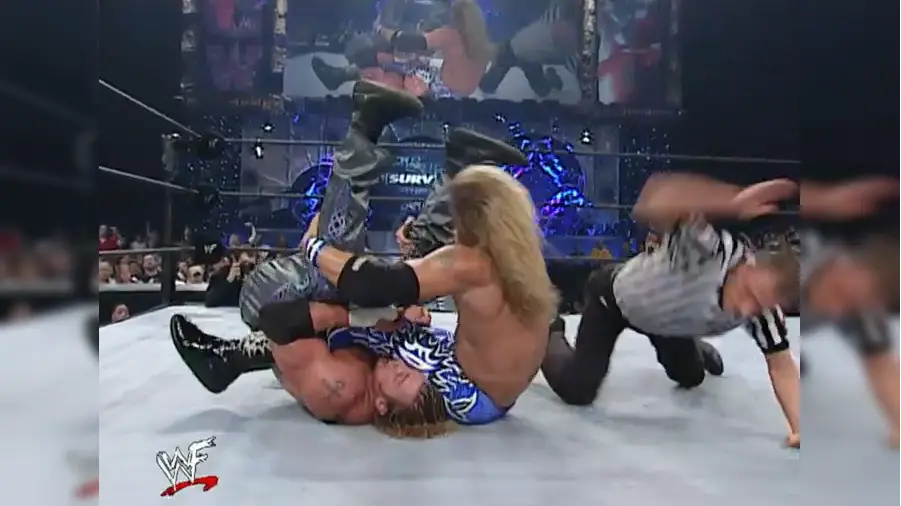 WWE
WWE
The singles push of Edge would continue on his night, defeating (as noted) Test to unify the Intercontinental and United States belts in what turned out to be a very good match. The final sequence embedded the hook deep in the lip of the collective audience, as the Greensboro crowd was living and dying on each near fall. It was masterful work from two of WWE's promising young guns.
It's even more impressive based on Edge's recollection of events. Earlier in the day, he and Test rehearsed the finishing spot, in which Edge used a front Victory Roll to counter a Full Nelson lift. In practising the move, Edge claims he landed right on his head and was in a hazy state for much of the remainder of the day which led to some mental struggles during the match itself. But to anybody watching, nothing seemed even slightly off.
 WWE
WWE
In what would be the first Women's Championship victory of her career, Trish Stratus won a six-way, one fall match over Lita, Jacqueline, Ivory, Molly Holly, and a debuting Jazz to capture the gold. The match was only about four minutes long, which would be a major point of contention in later years, but it was solid for what it was.
There was no champion headed into the match, as the belt hadn't been seen in close the six months. The previous titleholder was Chyna, who disappeared after her victory over Lita at the Judgment Day pay-per-view. Chyna had reportedly become more difficult to deal with, and she wasn't happy with her role in the women's division, preferring to work with men. Chyna's deal was allowed to expire, and WWE went without a visible Women's champion until Survivor Series.
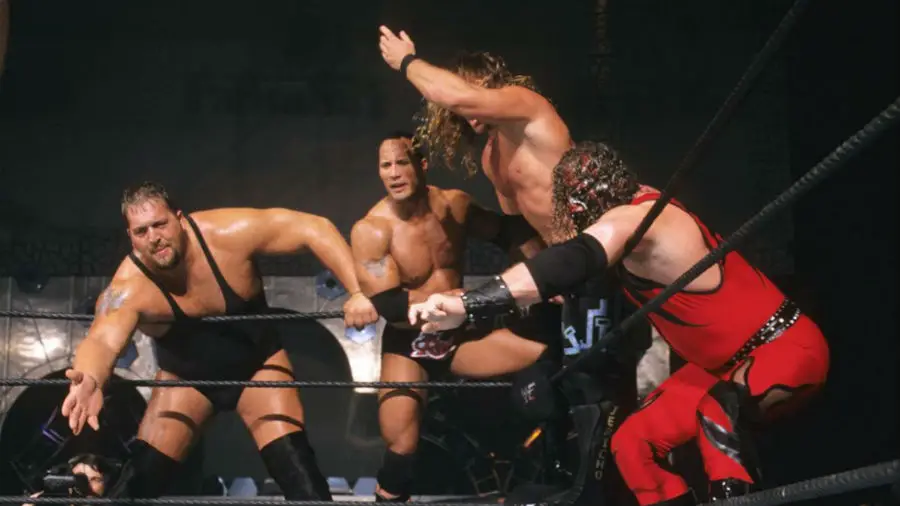 WWE
WWE
The main event, understandably, was the big five on five winner-takes-all match pitting WWE's best and brightest against The Alliance's strongest links. The winning side gets hailed as conquerors, while the losers disband, putting the majority of the army out of work (more on that later). Nothing else could possibly go on last, given the stakes, though the match's placement was a bit interesting.
It marked the first time in eight years that Survivor Series ended with an elimination match. After six of the first seven Survivor Series' ended with a Survivors bout, WWE would end the 1994 through 2000 shows with either a singles or triple threat bout, usually for the WWE Championship. The 1993 show ended with Lex Luger's All Americans team battling Yokozuna's Foreign Fanatics contingent, and in both the 1993 and 2001 examples, Undertaker took part in the match.
 WWE
WWE
Shane McMahon was one of the five wrestlers on the WCW/ECW fusion group (and why not - he's the Best in the World, after all), as it made sense that he'd want to help actively destroy WWE with his own hands. Originally, Vince McMahon was supposed to be Shane's counterpart on the WWE side, defending his turf like a pompadoured Kevin McAllister.
However, at some point early on in the build to the match, Vince took himself out of the big main event, and would be replaced by Big Show. Some sources have indicated that Vince had an injury of some sort at the time, and he'd last competed on Raw several weeks before the pay-per-view. It's not clear of any purported injury took place there or not.
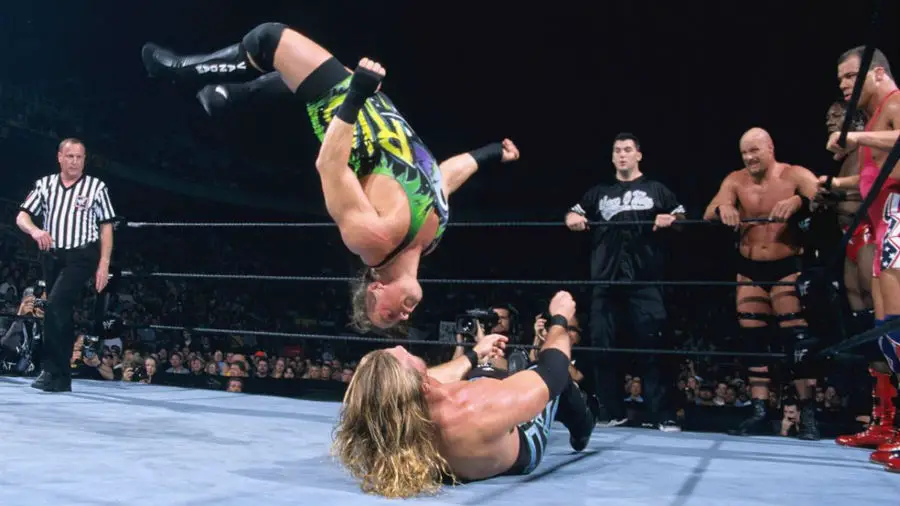 WWE
WWE
It can't be stressed enough the ways in which the Invasion angle disappointed audiences, whether it was the lack of big names in the attacking faction, or the fact that the ones who *were* there were treated so secondary. To give you an idea of just how meagre things had gotten for the fresher faces in The Alliance, look no further than the main event.
Out of the five men representing WCW and ECW, three of them were already WWE stars in Austin, Shane, and Kurt Angle. Only Booker T and Rob Van Dam represented the outsiders, those seeking revenge from beyond their former employers' graves. And since it was originally supposed to just be WWE vs. WCW, Booker T was the only invading WCW star that took part in the final battle. Sums it up well.
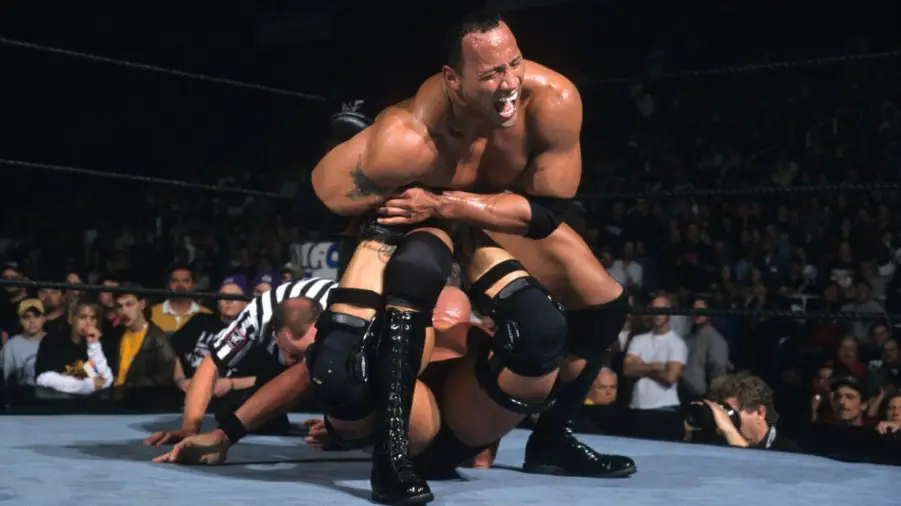 WWE
WWE
When Steve Austin and The Rock duked it out to finish WrestleMania X-Seven, very few people would have assumed that the last two men standing in the WWE vs WCW war would have been the same men, and even fewer would've thought they'd be on opposite sides of the critical fight. But they were, and Rock pinned Austin (with an assist from a mole in Angle) to vanquish The Alliance for good.
The match marked the first time that Rock had ever pinned Austin in any sort of match. Their history as rivals dated back four years, across several pay-per-view matches, and Austin always got over on his fellow megastar pillar. Rock finally added his own tally mark here, and an even bigger one 16 months later when he defeated Austin in his final match at WrestleMania XIX.
 WWE
WWE
As a result of WWE winning the winner-takes-all match at the end of Survivor Series, The Alliance members were banished from the company, with a few exceptions. If you had a belt (Rob Van Dam, The Dudley Boyz, Steve Austin), had won immunity (Test), done something degrading to stay (William Regal), or were Stacy Keibler (Stacy Keibler), you didn't go anywhere. As for the rest...well, they didn't stay gone long.
At the spate of house shows the following weekend, a number of supposedly-fired talents wrestled, including Diamond Dallas Page, Raven, Booker T, Tommy Dreamer, among many others. Many of them would find their way back onto WWE program without any story explanation anyway, making Survivor Series 2001 about as canonically irrelevant as...well, as some pay-per-views we may have seen recently.
Survivor Series 2001 would be the battleground in which the "moment of truth" took place, not that it was the culmination of an epic story. Instead, the event felt more like the jettisoning of a burden, a way to write off the entire sorry mess in one night, before moving on to matters that a victorious Vince McMahon would rather sink his creative teeth into.
It must be said that for the most part, the 2001 Survivor Series was a pretty enjoyable show, with an exciting five-on-five main event, and two unification matches were up to snuff. It was, however, hard to override the disappointing taste of the squandered storyline, that although WWE made somewhat good on the high stakes on the angle's last day, it doesn't undo all the prior damage.
10. Killing The Town
 WWE
WWEAfter the dust settled at WrestleMania X-Seven, interest in the WWE product began to slowly wane. Trendies had flocked elsewhere, the wrestling boom was dying, and Stone Cold Steve Austin was no longer the cool anti-hero that had starred in WWE's resurgence. Perhaps a hearty Invasion angle could have bolstered the fading audience (the July PPV was the highest non-WrestleMania buyrate ever), but by November, things were much grimmer.
Although the event did the second highest amount of buys in Survivor Series history (450,000 for the blowoff), putting asses in seats was a harder task. According to Figure 4 Weekly, a high volume of tickets were still available just two days before the pay-per-view, including some $300 seats. Barely 8000 people paid for admission (with 2000 more comped) to the Greensboro Coliseum, a building that held more than 19,000 for the 1999 King of the Ring. That's, uh, quite a drop.
9. Watered Down Army
 WWE
WWEIt wasn't a true WCW invasion without the big guns, like Sting, Ric Flair, Goldberg, Scott Steiner, among others. And you knew things were rough when WWE fortified the invader ranks not only with ECW mercenaries, but also WWE defectors like Steve Austin and Kurt Angle. By the time fall rolled around, the Alliance was functionally Austin and the McMahon children barking out orders to Rob Van Dam, Booker T, and a collection of mostly-faceless henchmen.
To give you an idea of just how bad things were at the end, of the 48 individuals that wrestled at Survivor Series, only 12 of them debuted as an invader, meaning the other 36 were already on the WWE roster. Nine of those 12 were thrown into the midcard job security battle royal, while the other three (Van Dam, Booker, and a debuting Jazz) were highlighted in matches of higher significance.
8. Keeping It Light
 WWE
WWEThe 2001 Survivor Series included, as noted in my intro, two unification matches to help bring a smooth end to the entire Invasion debacle. One match saw Edge defeat Test to combined the Intercontinental and United States belts, while the Dudleyz conquered Matt and Jeff Hardy to unify both sets of Tag Team belts. There was to have been a third unification match as well.
On the show, WWE Light Heavyweight Champion X-Pac was to face WCW Cruiserweight Champion Tajiri. However, the match would end up not taking place, due to Sean Waltman being sidelined with an injury in late-October. Waltman wouldn't return to action until March, though by that time WWE had done away with the Light Heavyweight belt, moving forward with the Cruiserweight gold and its respective lineage.
7. Practice Makes Painful
 WWE
WWEThe singles push of Edge would continue on his night, defeating (as noted) Test to unify the Intercontinental and United States belts in what turned out to be a very good match. The final sequence embedded the hook deep in the lip of the collective audience, as the Greensboro crowd was living and dying on each near fall. It was masterful work from two of WWE's promising young guns.
It's even more impressive based on Edge's recollection of events. Earlier in the day, he and Test rehearsed the finishing spot, in which Edge used a front Victory Roll to counter a Full Nelson lift. In practising the move, Edge claims he landed right on his head and was in a hazy state for much of the remainder of the day which led to some mental struggles during the match itself. But to anybody watching, nothing seemed even slightly off.
6. Chyna's Loss Is Trish's Gain
 WWE
WWEIn what would be the first Women's Championship victory of her career, Trish Stratus won a six-way, one fall match over Lita, Jacqueline, Ivory, Molly Holly, and a debuting Jazz to capture the gold. The match was only about four minutes long, which would be a major point of contention in later years, but it was solid for what it was.
There was no champion headed into the match, as the belt hadn't been seen in close the six months. The previous titleholder was Chyna, who disappeared after her victory over Lita at the Judgment Day pay-per-view. Chyna had reportedly become more difficult to deal with, and she wasn't happy with her role in the women's division, preferring to work with men. Chyna's deal was allowed to expire, and WWE went without a visible Women's champion until Survivor Series.
5. Surviving The Finale
 WWE
WWEThe main event, understandably, was the big five on five winner-takes-all match pitting WWE's best and brightest against The Alliance's strongest links. The winning side gets hailed as conquerors, while the losers disband, putting the majority of the army out of work (more on that later). Nothing else could possibly go on last, given the stakes, though the match's placement was a bit interesting.
It marked the first time in eight years that Survivor Series ended with an elimination match. After six of the first seven Survivor Series' ended with a Survivors bout, WWE would end the 1994 through 2000 shows with either a singles or triple threat bout, usually for the WWE Championship. The 1993 show ended with Lex Luger's All Americans team battling Yokozuna's Foreign Fanatics contingent, and in both the 1993 and 2001 examples, Undertaker took part in the match.
4. The Boss Tags Out
 WWE
WWEShane McMahon was one of the five wrestlers on the WCW/ECW fusion group (and why not - he's the Best in the World, after all), as it made sense that he'd want to help actively destroy WWE with his own hands. Originally, Vince McMahon was supposed to be Shane's counterpart on the WWE side, defending his turf like a pompadoured Kevin McAllister.
However, at some point early on in the build to the match, Vince took himself out of the big main event, and would be replaced by Big Show. Some sources have indicated that Vince had an injury of some sort at the time, and he'd last competed on Raw several weeks before the pay-per-view. It's not clear of any purported injury took place there or not.
3. The Grave Remains
 WWE
WWEIt can't be stressed enough the ways in which the Invasion angle disappointed audiences, whether it was the lack of big names in the attacking faction, or the fact that the ones who *were* there were treated so secondary. To give you an idea of just how meagre things had gotten for the fresher faces in The Alliance, look no further than the main event.
Out of the five men representing WCW and ECW, three of them were already WWE stars in Austin, Shane, and Kurt Angle. Only Booker T and Rob Van Dam represented the outsiders, those seeking revenge from beyond their former employers' graves. And since it was originally supposed to just be WWE vs. WCW, Booker T was the only invading WCW star that took part in the final battle. Sums it up well.
2. At Long Last
 WWE
WWEWhen Steve Austin and The Rock duked it out to finish WrestleMania X-Seven, very few people would have assumed that the last two men standing in the WWE vs WCW war would have been the same men, and even fewer would've thought they'd be on opposite sides of the critical fight. But they were, and Rock pinned Austin (with an assist from a mole in Angle) to vanquish The Alliance for good.
The match marked the first time that Rock had ever pinned Austin in any sort of match. Their history as rivals dated back four years, across several pay-per-view matches, and Austin always got over on his fellow megastar pillar. Rock finally added his own tally mark here, and an even bigger one 16 months later when he defeated Austin in his final match at WrestleMania XIX.
1. Back So Soon?
 WWE
WWEAs a result of WWE winning the winner-takes-all match at the end of Survivor Series, The Alliance members were banished from the company, with a few exceptions. If you had a belt (Rob Van Dam, The Dudley Boyz, Steve Austin), had won immunity (Test), done something degrading to stay (William Regal), or were Stacy Keibler (Stacy Keibler), you didn't go anywhere. As for the rest...well, they didn't stay gone long.
At the spate of house shows the following weekend, a number of supposedly-fired talents wrestled, including Diamond Dallas Page, Raven, Booker T, Tommy Dreamer, among many others. Many of them would find their way back onto WWE program without any story explanation anyway, making Survivor Series 2001 about as canonically irrelevant as...well, as some pay-per-views we may have seen recently.
